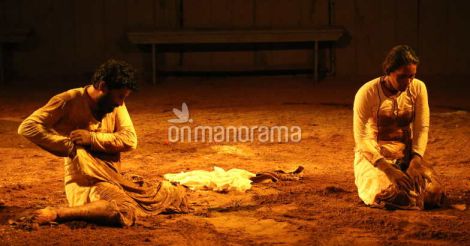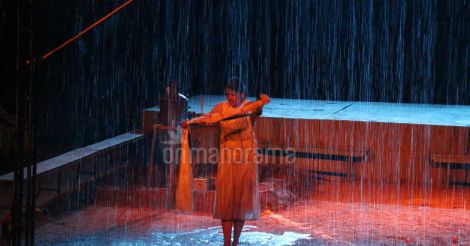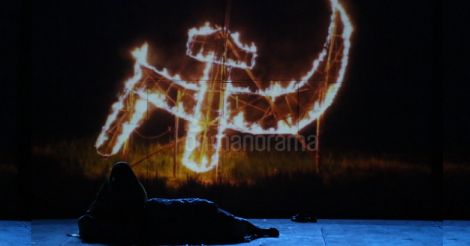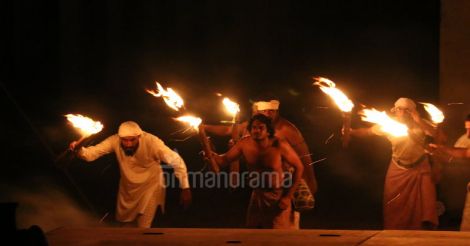Back home after watching Deepan Sivaraman's "independent adaptation" of O.V. Vijayan's canonical "Khasakinte Ithihasam" (The Legends of Khasak) on stage, I was wondering what would have been my reaction had I not read the original work. I also wonder what drew the huge crowd on the grounds of Kodungalloor Boys' School with a ticket to watch the play—was it their love for theatre, or the novel, or both?
And all these dilemma because it's Khasak—the 1969 novel that hailed the new dawn in Malayalam fiction with its thematic and narrative novelties. Noted as a work of art which is reluctant to fit itself into another genre, many are known to have abandoned the projects to translate Vijayan's magnum opus into either stage or screen. Hence applause in the first place to Sivaraman for his brilliant and brave attempt to bring alive the fabled Khasak on to stage, an open stage.
 Soil plays an important role in the stage.
Soil plays an important role in the stage.The difficulties in adapting the novel into theatre or film lies in the nature of the text—a strange blend of strong philosophical, psychological and political themes laced with the beauty of language, wrapped in a complex narrative. Still, for a person whose medium is theatre, the text remains luring with all its dark colours, intense odours and loud voices. And Sivaraman's play is a total triumph wherein all that is visual in the text is put up on brilliant display.
In the process of the adaptation, the dramatist makes Khasak, the place, the protagonist rather than the guilt-driven young teacher Ravi who has left behind his home, father and his beloved. The play does everything that is possible within the confines of the space. The stage is set as Khasak, with a suggestive sprawling fields in all the three sides, Aliyar's tea shop and Madhavan Nair's stitching centre on each side, Ravi's single-teacher school on the dais, Mollakka and Maimuna's house in the box-like centre stage and so on. The open space in the middle transforms itself into many in the process of unfolding the drama. With a few strokes, Alla Picha Mollakka makes it his madrassa. In the next scene, the minaret is erased by an angry Sivaraman Nair, maybe the first Islamophobe in Malayalam fiction, with his feet. It is only one example of the many occasions of natural transformation of settings in the play.
 A scene from the play. Photo: Sajesh Mohan
A scene from the play. Photo: Sajesh MohanFinding a strong motif in soil, the dramatist makes maximum use of the centre stage. Nizam Ali makes love with Maimuna and fights with Ravi in the wet soil. Mungamkozhi digs a well in the centre stage and later, gets buried in it. On several occasions, Nizam Ali, Ravi and Maimuna enter in neat white clothes and leave the stage clad in mud. Use of scent is another technique the dramatist frequently uses. The odours of perfume, talcum powder and incense sticks and the reek of gunpowder and kerosene fill the stage throughout the narrative. Fire is frequently used to indicate the rage within Nizam Ali.
During the 200-minute on-stage action, Sivaraman takes a leaf out of various stages of Malayalam theatre. On acting, the play leans against the traditional popular theatre, whereas in all other elements, it goes for the techniques of the alternative theatre that has its roots in the native folk cultures. The play also depends on video during several occasions. The play carves out every opportunity for humour from the original text which is noted for its heavy philosophical questions. The way Mungamkozhi's snore transforms into “inquilab zindabad” as a prelude to Nizam Ali's brief stint as a communist is an example.
 The play also depends on video on several occasions. Photo: Sajesh Mohan
The play also depends on video on several occasions. Photo: Sajesh MohanWhile, the first one in which Ravi's father (a character that never appears in the novel except through the mention of a letter and Ravi's memories) is shown to establish the mental agonies Ravi undergoes, and the visuals of an igniting 'sickle and hammer' looked apt, the video in the last part in which the interaction between Ravi and Padma are seen, despite having them real on the last layer of the stage, seemed unnecessary. The fifth wall was broken several times by actors, making spectators the citizens of Khasak.
The use of puppetry, especially to depict the sensual relationship between Ravi and his stepmother, which is the key to the future events in the novel, is commendable.
Music by Chandran Veyyattummal keeps the spirit of the narrative alive each moment with the beauty of native and Arabic strings and percussion. The lighting by Jose Koshy and the props by artist Anto George—the puppet of Ravi's stepmother, masks of Appukili's "four mothers" and the crown of the 'goddess of smallpox'—all were exceptional and highly theatrical.

The play does bring to stage all the major events in the novel and makes a spectacle at feasible junctures. The fireworks in the darkness and rains drenched in rich blue light make Khasak a real-life experience. The dramatist takes his freedom on several occasions, but the one during the climax, apparently made to make the summit scene a little more dramatic, might not go down well with the devotees of 'Khasakinte Ithihasam', the novel.
Whether the drama could capture and convey the inner struggles of many of its characters, especially Ravi, is doubtful. But then, let it remain in the domain of the original work. As for stage and its lovers, Sivaraman's attempt to recreate Khasak and the efforts of each one associated with KMK Smaraka Kalasamithi, Thrikarippur, deserve a standing ovation.
Check out this space for a video footage and an interview with Deepan Sivaraman.

























 With the story of the origin of the people of Khasak played in the backdrop, characters emerge from the darkness. Photo: Sajesh Mohan
With the story of the origin of the people of Khasak played in the backdrop, characters emerge from the darkness. Photo: Sajesh Mohan